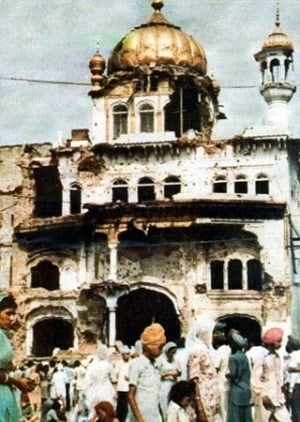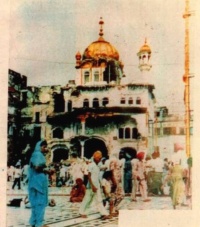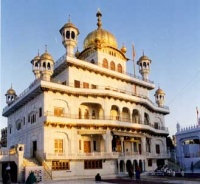Operation Bluestar: Difference between revisions
Gurudas1947 (talk | contribs) |
Gurudas1947 (talk | contribs) |
||
| Line 25: | Line 25: | ||
==Operation Blue Star - Aftermath== | ==Operation Blue Star - Aftermath== | ||
Ahmad Shah Abdali destroyed all the Gurdwara in his path. Muslims destroyed 100s of Gurudwaras in 1947. | |||
[[Image:Aftermath.jpg|thumb|200px|right|Aftermath]] | [[Image:Aftermath.jpg|thumb|200px|right|Aftermath]] | ||
| Line 36: | Line 38: | ||
*http://www.saintsoldiers.net | *http://www.saintsoldiers.net | ||
*http://www.neverforget84.com | *http://www.neverforget84.com | ||
=Operation Bluestar - Detailed Account= | =Operation Bluestar - Detailed Account= | ||
Revision as of 09:08, 12 August 2007

Operation Bluestar
Background
On 13th April 1977, head Nirankaris named Gurbachan was attacked by armed thugs of Bhindranwala.
A peaceful samagam was attacked. what Khalistani elements would never tell you, four Nirankaris were also killed in this totally unprovoked attack.
Bhindrenwale and his group had moved to hide in Akal Takht, the highest seat of Sikh authority few weeks before Army operation. He had been criticized for this act as he became the only person after Guru Hargobind to live in Akal Takht. He was obviously spearheading the last showdown with Indian army and had knowledge that sooner or later Army would attack and he himself wanted to go down in Sikh history as a martyr and not deserter or negotiator as other Akalis political leaders. why he had to hide in Harimandir, his supporters cannot provide any credible argument.
He had support of ratbags like Major General Shabeg Singh, as well as thousands of rural Sikh youth.
Brar's superior officer was Lt-General Krishnaswamy Sunderji, who asked his chief staff Officer, Lt-General Ranjit Singh Dayal, to draw up the plans for Operation Blue Star. Dayal, like Brar was a Sikh, but he had not shaved his beard or cut his hair, and still wore a turban. Dayal was also an infantry soldier, having served in the Ist Battalion, the Parachute Regiment, which was to spearhead the attack on the Golden Temple Complex. During the 1965 war with Pakistan, Dayal became legend by capturing a pass which had previously been thought to be impregnable, and blocking off one of the most important routes from Pakistan-Controlled Kashmir into Indian state of Jammu and Kashmir. A frontal assault was impossible and so Lt-General Dayal climbed up the mountains towering over Haji Pir pass and came down on top of the Pakistanis.
Dayal, Sundarji and Brar drew up at twofold plan. The essence of this plan was to separate the hostel complex from the Temple complex so that the hostels could be evacuated without becoming involved in the main battle. To achieve the prime objective to get Bhindrenwale out of the temple complex they had planned a commando operations. Commandos were to be supported by infantry, Tanks were only to be used as platforms for machine guns to neutralize fire on troops approaching the Golden Temple complex, and to cover the Temple exits in case anyone tried to escape. Armored personnel carriers were to be positioned on the road separating the hostels from the Temple complex to keep the two potential battle fields apart.
Operation Bluestar
Operation Blue Star
Singho dont use this site to spread hatred. Overcome Kaam, krodh, lobh, etc. Hatred is not an attribute of a Sikh. Bhul Chuk maaf
Operation Blue Star - Aftermath
Ahmad Shah Abdali destroyed all the Gurdwara in his path. Muslims destroyed 100s of Gurudwaras in 1947.
For more pictures and information visit the following sites:
- http://www.sikh-history.com
- http://www.searchsikhism.com
- http://www.allaboutsikhs.com
- http://www.sikhlionz.com
- http://www.saintsoldiers.net
- http://www.neverforget84.com
Operation Bluestar - Detailed Account
Background
Operation Blue Star was a code name given by the Indian government to an attacked when launched on the Golden Temple, the holiest shrine of the Sikhs. The attack, initiated on May 31st 1984, was one of the most effective operation to weed out terrorists from the holy shrine named Harimandir (Hari's Temple).
Operation Bluestar
Why spread falsehood? who is this writer pretending to be a Sikh and spreading nothing but hatred for other dharams?
Singho dont use this site to spread hatred. Overcome Kaam, krodh, lobh, etc. Hatred is not an attribute of a Sikh. Bhul Chuk maaf
Aftermath
Investigation into the Kanishka Bombing 1985
The arrest of three Sikh terrorists in Vancouver, Canada for their alleged role in the bombing of an Air India (AI) flight on June 23, 1985 marks a crucial stage in the 15-year investigation carried out by the Canadian authorities in cooperation with the Indian government into the incident. The AI flight 182 Kanishka on June 23, 1985 from Toronto with a brief stopover at Montreal was en route to New Delhi when it exploded off, the coast of Ireland while it was preparing to land at the Heathrow airport. The mid-air explosion which killed all the 329 people on board is widely considered to be one of the world's deadliest acts of terrorism and civilian aviation sabotage. Investigations reveal that it was one of two related bomb explosions allegedly carried out by Sikh terrorists. The other explosion occurred at the Narita airport in Tokyo killing two people.
The long drawn-out investigation, still in progress, into the AI flight bombing has been carried out by the Royal Canadian Mounted Police (RCMP) in conjunction with police authorities in India, North America, Europe and Asia. After a 15-year probe, the RCMP on October 27, 2000 arrested two Sikh terrorists based in Canada for their alleged role in the incident. The RCMP arrested another unidentified suspect on October 29, 2000 and released him on bail after interrogating him for nearly 24 hours. The two terrorists arrested on October 27 identified as Ripudaman Singh Malik and Ajaib Singh Bagri have been remanded to judicial custody in Vancouver. Two other terrorist, Talwinder Singh Parmar and Inderjit Singh Reyat have been declared as co-conspirators in both the incidents. Talwinder Singh Parmar, a Babbar Khalsa terrorist was killed by the Punjab Police in 1992. Inderjit Singh Reyat was sentenced in 1991 to serve a 10-year imprisonment for manufacturing the bomb intended to blow-up the AI flight. Both Ripudaman Singh Malik and Ajaib Singh Bagri been charged on eight counts including criminal conspiracy and fist-degree murder.
Canadian authorities after protracted investigations have made a preliminary ascertainment to the effect that the flight was destroyed through a bomb that passed through the security-check at the Vancouver airport onto a Canadian Pacific airline. The bomb then found its way to the AI flight Kanishka in Toronto. Indications are that an unidentified suspect brought air tickets in Vancouver that allowed the two bomb-laden suitcases to pass through airport security. No passenger boarded the flight with these tickets. One of the two suitcases was transferred in Toronto to AI flight 182. The other suitcase was to have been transferred to an AI flight from Japan to India. But, the bomb exploded prematurely at the Narita airport in Tokyo killing two baggage handlers. The unidentified suspect was arrested in Canada as early as November 1985 but was released due to lack of evidence. Inderjit Singh Reyat was found guilty of manslaughter and making explosive substances among other charges and received a 10-years sentence and a firearm prohibition of 5 years for his role in the Narita airport incident.
The Canadian authorities, in the aftermath of the bombing, suspected Sikh terrorists of planting the bombs in revenge for 'Operation Blue Star', the 1984 security forces raid aimed at flushing out terrorists from the Golden temple in Amritsar. According to an RCMP spokesperson, the bombings were planned and organised in Canada. The Canadian probe, the longest and one of the costliest - the RCMP is reported to have already incurred an expenditure of 30 million Canadian dollars - was also a complex investigative process as it had too many people to interrogate in various countries. Moreover, in the initial phase, the authorities were unsure about the place or origin of the bombs - Canada, India or elsewhere. In the light of the evidence gathered so far and the recent arrests, the RCMP is in the process of planning arrests of at least four other suspects. The RCMP also believes that the release of a third suspect-although unidentified, sources claim that it was Hardiyal Singh Johal, a 'prominent ' member of the Sikh community in British Columbia- would not be a setback to the ongoing investigation process and the formal charging of the suspects in the British Columbia Supreme Court.
Immediately after the 1985 bombing of the Kanishka, the Indian government had instituted the Justice B.N Kirpal Commission of Inquiry. The main agenda of the Kirpal Commission was to explore whether AI flight 182 had crashed due to an explosion, a machine failure, or human error. It arrived at a clear conclusion that the AI flight had exploded in mid-air and had fallen into the ocean because of a bomb which had planted in Canada. The Central Bureau of Investigation (CBI), which had assisted the RCMP in its probe also constituted a investigation process. The CBI findings established that the bombing was the handiwork of Babbar Khalsa International (BKI), a terrorist outfit in Punjab and the mastermind was Talwinder Singh Parmar, a frontranking leader of the same outfit. Since the main area of investigation is in Canada, the CBI was largely associated in collecting information, documents and evidence sought by the RCMP.
Official sources in India have reported that the while the Indian government views the arrests of the terrorists as a positive development, it would wait for the completion of the probe by the Canadian authorities before deciding on any future course of action. Reports also indicate that the government has so far not made any official request for the extradition of the arrested suspects as the offence was committed in Canada and the trial is also due to take place in the same country. Moreover, there are no proceedings pending against the arrested terrorists in India.
Pictures
According to media reports, police recovered 114 grenades, mostly rusted, from a construction site in the Golden Temple complex in Amritsar on January 10. The devices were buried by Sikh militants during the 1984 ‘Operation Blue Star’ period. Dalmegh Singh, secretary of the Shiromani Gurdwara Parbandhak Committee, said the devices were noticed when labourers were digging the earth for laying the foundation for an administrative block. The police said the recovered weapons are HE-36 grenades, used by militants then
Who brought in these weapons? Who desecrated our gurughars? Who were those cowards who left faeces in near Sri Guru Granth Sahib in Harimandir Sahib during OPeration Black Thunder?


